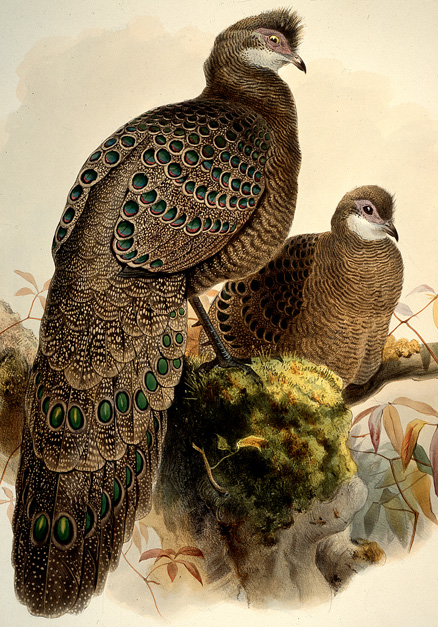 Grey
Peacock-pheasant
Grey
Peacock-pheasantPolyplectron bicalcaratum (Linnaeus)
 Grey
Peacock-pheasant
Grey
Peacock-pheasant
In their native habitat, these birds are found in southeast Asia: Sikkim east through Burma, and south-east to Indochina, plus the island of Hainan (Johnsgard 1986). There are five subspecies of this bird which is also known as the Iris Peacock-pheasant or Chinquis Pheasant.
Grey Peacock-pheasants are shy and secretive birds which inhabit some of the most dense, tropical jungle available on earth, from sea level to 6,000 feet. Beebe (1937) describes their habitat as so inaccessible that if an individual was able to progress more than a hundred yards in an hour, he would have to be in the wrong area. Similarly, if a collector chose to locate these birds in areas not as dense, he would encounter "all sorts of beasts, each more dangerous than the other."
The first specimens to reach England were delivered to James Monroe of London in 1745, but no more were imported until the mid-nineteenth century. In 1857, the species was reintroduced and according to Wayre (1969), the Grey Peacock-pheasant was reared in captivity from 1863 onward, requiring a closed shelter only under very severe winter conditions In the twentieth century these birds have become one of the more popular peacock-pheasants in captivity.
Peacock-pheasant body feathers were historically never used in salmon fly dressings until 1981 when the senior author created the Purple Leopard with feathers from the Malayan Peacock-pheasant (Polyplectron malacense), one of seven species of Peacock-pheasant. Since additional feathers from the Malayan Peacock-pheasant were difficult to procure, the senior author revealed that feathers from the other species were available from aviculturalists around the world. These included the Bronze-tailed Peacock-pheasant (Polyplectron chalcurum), the Rothchild's Peacock-pheasant (Polyplectron inopinatum), the Grey Peacock-pheasant (Polyplectron bicalcaratum), the Bornean Peacock-pheasant (Polyplectron schleiermacheri), the Germain's Peacock-pheasant (Polyplectron germaini), and the Palawan Peacock-pheasant (Polyplectron emphanum). Today, gray peacock pheasants are reared extensively in captivity. In fly tying, both body and tail feathers from the Gray Peacock-pheasant and the Bornean Peacock-pheasant are the most popular, and are used extensively in artistic salmon flies.
If you want to know more about the peacock pheasants and other birds related to our fly tying heritage, we suggest you order Rare and Unusual Fly Tying Materials: A Natural History.
RETURN TO FLY